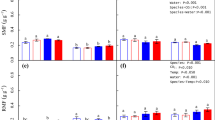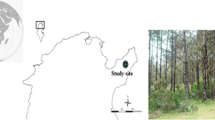Abstract
Recent studies suggest that physiological traits can be affected by tree size due to stronger hydraulic limitation in taller trees. As trees vary greatly in size, both within and among species, the adaptive responses to hydraulic limitation may be different among species with different maximum sizes. To investigate this, we explored size-dependency in photosynthetic and hydraulic parameters of three Acer species (Acer mono Maxim., Acer amoenum Carr and Acer japonicum Thunb.) using trees of various sizes under well-lit conditions. Leaf stomatal conductance of the Acer species decreased with tree size, implying that water supply to leaves decreases as trees grow. In contrast, content of nitrogen increased with tree size, which may compensate for the decrease in stomatal conductance to maintain the photosynthetic rate. Although the increase in nitrogen and leaf mass per area were larger in species with larger statures, the size-dependency in stomatal conductance was not different among species, and photosynthetic rate and hydraulic conductance were maintained in the three Acer species. Therefore, we suggest that hydraulic limitation on gas exchange does not necessarily depend on the maximum height of the species and that maintenance of photosynthesis and hydraulic properties is a fundamental physiological process during tree growth.





Similar content being viewed by others
References
Abe S, Masaki T, Nakashizuka T (1995) Factors influencing sapling composition in canopy gaps of a temperate deciduous forest. Vegetatio 120:21–32
Akaike H (1973) Information theory and an extension of the maximum likelihood principle. In: Petrov BN, Csaki F (eds) Second international symposium on information theory. Akademiai Kiado, Budapest, pp 267–281
Barnard HR, Ryan MG (2003) A test of the hydraulic limitation hypothesis in fast-growing Eucalyptus saligna. Plant Cell Environ 26:1235–1245
Bauerle WL, Hinckley TM, Cermak J, Kucera J, Bible K (1999) The canopy water relations of old Douglas-fir trees. Trees 13:211–217
Bond BJ (2000) Age-related changes in photosynthesis of woody plants. Trends Plant Sci 5:349–353
Brodribb TJ, Holbrook NM, Gutierrez MV (2002) Hydraulic and photosynthetic co-ordination in seasonally dry tropical forest trees. Plant Cell Environ 25:1435–1444
Brodribb TJ, Holbrook NM, Edwards EJ, Gutierrez MV (2003) Relations between stomatal closure, leaf turgor and xylem vulnerability in eight tropical dry forest trees. Plant Cell Environ 26:443–450
Crawley MJ (2005) Statistics: an introduction using R. Wiley, West Sussex
Evans JR (1989) Photosynthesis and nitrogen relationships in leaves of C-3 plants. Oecologia 78:9–19
Hiura T, Fujito E, Ishii T, Naniwa A, Sugata S, Ishida K, Murakami M, Kato E, Maeno H, Fukushima Y, Sakai T (1998) Stand structure of deciduous broad-leaved forest in Tomakomai experimental forest, based on large-plot data. Res Bull Hokkaido Univ For 55:1–10
Hubbard RM, Bond BJ, Ryan MG (1999) Evidence that hydraulic conductance limits photosynthesis in old Pinus ponderosa trees. Tree Physiol 19:165–172
Ishida A, Yamamura Y, Hori Y (1992) Roles of leaf water potential and soil-to-leaf hydraulic conductance in water-use by understorey woody-plants. Ecol Res 7:213–223
Ishida A, Toma T, Matsumoto Y, Kheong Y, Maruyama Y (1996) Diurnal changes in leaf gas exchange characteristics in the uppermost canopy of a rain forest tree, Dryobalanops aromatica Gaertn. f. Tree Physiol 16:779–785
Jones HG (1992) Plants and microclimate, 2nd edn. Cambridge University Press, Cambridge, pp 62–63
Kikuzawa K (1983) Leaf survival of woody plants in deciduous broad leaved forests. Can J Bot 61:2133–2139
Koch GW, Sillett SC, Jennings GM, Davis SD (2004) The limits to tree height. Nature 428:851–854
Koike T (1988) Leaf structure and photosynthetic performance as related to the forest succession of deciduous broad-leaved trees. Plant Sp Biol 3:77–87
Magnani F, Mencuccini M, Grace J (2000) Age-related decline in stand productivity: the role of structural acclimation under hydraulic constraints. Plant Cell Environ 23:251–263
Marshall JD, Monserud RA (2003) Foliage height influences specific leaf area of three conifer species. Can J For Res 33:164–170
McDowell N, Barnard H, Bond BJ, Hinckley T, Hubbard RM, Ishii H, Kostner B, Magnani F, Marshall JD, Meinzer FC, Phillips N, Ryan MG, Whitehead D (2002) The relationship between tree height and leaf area: sapwood area ratio. Oecologia 132:12–20
Meinzer FC (2003) Functional convergence in plant responses to the environment. Oecologia 134:1–11
Meinzer FC, Goldstein G, Franco AC, Bustamante M, Igler E, Jackson P, Caldas L, Rundel PW (1999) Atmospheric and hydraulic limitations on transpiration in Brazilian cerrado woody species. Funct Ecol 13:273–282
Mencuccini M (2002) Hydraulic constraints in the functional scaling of trees. Tree Physiol 22:553–565
Mencuccini M, Magnani F (2000) Comment on ‘hydraulic limitation of tree height: a critique’ by Becker, Meinzer and Wullschleger. Funct Ecol 14:135–137
Midgley JJ (2003) Is bigger better in plants? The hydraulic costs of increasing size in trees. Trends Ecol Evol 18:5–6
Murakami M, Hiura T (2003) The international canopy crane network: Tomakomai Experimental Forest, Japan. In: Basset Y, Horlyck V, Wright SJ (eds) Studying forest canopies from above: the international canopy crane network. Smithsonian Tropical Research Institute and the United Nations Environmental Programme, Panama, pp 90–97
Nabeshima E, Hiura T (2004) Size dependency of photosynthetic water- and nitrogen-use efficiency and hydraulic limitation in Acer mono. Tree Physiol 24:745–752
Oguchi R, Hikosaka K, Hiura T, Hirose T (2006) Leaf anatomy and light acclimation in woody seedlings after canopy gap formation in a cool-temperate deciduous forest. Oecologia 149:571–582
Onoda Y, Hikosaka K, Hirose T (2004) Allocation of nitrogen to cell walls decreases photosynthetic nitrogen-use efficiency. Funct Ecol 18:419–425
Pearcy RW, Schulze ED, Zimmerman R (1989) Measurement of transpiration and leaf conductance. In: Pearcy RW, Ehleringer JR, Mooney HA, Rundel PW (eds) Plant physiological ecology: field methods and instruction. Chapman & Hall, New York, pp 137–160
Reich PB, Uhl C, Walters MB, Elsworth DS (1991) Leaf lifespan as a determinant of leaf structure and function among 23 amazonian tree species. Oecologia 86:16–24
Ryan MG, Yoder BJ (1997) Hydraulic limits to tree height and tree growth. Bioscience 47:235–242
Ryan MG, Phillips N, Bond BJ (2006) The hydraulic limitation hypothesis revisited. Plant Cell Environ 29:367–381
Sakai S (1987) Patterns of branching and extension growth of vigorous saplings of Japanese Acer species in relation to their regeneration strategies. Can J Bot 65:1578–1585
Sakai S (1990) Sympodial and monopodial branching in Acer: implications for tree architecture and adaptive significance. Can J Bot 68:1549–1553
Santiago LS, Goldstein G, Meinzer FC, Fisher JB, Machado K, Woodruff D, Jones T (2004) Leaf photosynthetic traits scale with hydraulic conductivity and wood density in Panamanian forest canopy trees. Oecologia 140:543–550
Shibata H, Kirikae M, Tanaka Y, Sakuma T, Hatano R (1998) Proton budgets of forest ecosystems on volcanogenous regosols in Hokkaido, northern Japan. Water Air Soil Pollut 105:63–72
Sperry JS (1995) Limitations on stem water transport and their consequences. In: Gartner BL (ed) Plant stems. Academic, San Diego, pp 105–124
Thomas SC (1996) Asymptotic height as a predictor of growth and allometric characteristics Malaysian rain forest trees. Am J Bot 83:556–566
Thomas SC, Winner WE (2002) Photosynthetic differences between saplings and adult trees: an integration of field results by meta-analysis. Tree Physiol. 22:117–127
Uraguchi A, Kubo T (2005) Responses to light in individual growth and reproduction of two Acer species and the long-term consequences. Ecol Res 20:177–187
Woodruff DR, Bond BJ, Meinzer FC (2004) Does turgor limit growth in tall trees? Plant Cell Environ 27:229–236
Zimmerman R (1983) Xylem structure and the ascent of sap. Springer, Berlin
Acknowledgments
We thank A. Ishida, T. Saito and Y. Fukushima for their valuable comments and discussions. We also thank the staff of TOEF (Hokkaido University) for arrangements at the study site. This work was supported in part by grants from MESSC Japan (15208014, 16208014) to T.H.
Author information
Authors and Affiliations
Corresponding author
About this article
Cite this article
Nabeshima, E., Hiura, T. Size-dependency in hydraulic and photosynthetic properties of three Acer species having different maximum sizes. Ecol Res 23, 281–288 (2008). https://doi.org/10.1007/s11284-007-0374-z
Received:
Accepted:
Published:
Issue Date:
DOI: https://doi.org/10.1007/s11284-007-0374-z




